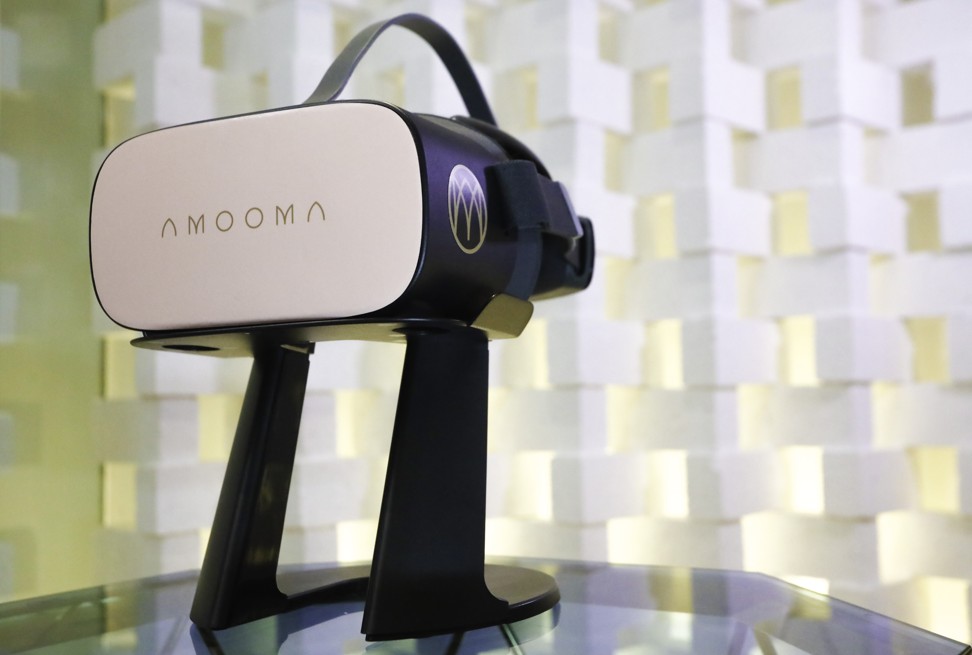
Spas and VR: new stress busting wellness experiences see you travel the world – even the moon – for meditation and relaxation
- The latest in virtual reality provides the chance of a break from city life without the worry and inconvenience of airports and planning a trip abroad
- Spas, wellness centres and even medical clinics are finding ways to use it to help clients relax and stay healthy
In the midst of the social unrest in Hong Kong, I faced a deliciously difficult decision: pick one of 10 fabulous destinations for an instant escape. I narrowed it down to a shortlist of three: a tropical rainforest, a spot to admire the Northern Lights, or the moon. Yes, really – the moon. It was a no-brainer, right?
There was no need for astronaut training, no bulky spacesuit. I just sat back, relaxed and within minutes was on the moon’s mottled surface. Ahead of me the Milky Way glimmered; to my right our planet Earth, looking every bit the beautiful little blue marble, gently turned.
I breathed deeply and exhaled slowly, following the melodic instructions of a distant narrator. It felt so good that I extended my five-minute trip to 15 minutes.
VR offers the opportunity of a break from city life without the ordeal and inconvenience of airports and travel stress. W Hong Kong’s Bliss Spa became the first place in Asia to offer VR-led spa treatments last year, and now Amooma is following with Sousou, a range of VR experiences that promise to immerse you in faraway, exotic worlds.
“We are using VR technology to add another dimension to our spa. It offers a quick escape for those in Hong Kong,” says spa manager Ganga Gurung, explaining that Sousou is a Chinese word which means “searching yourself”.
For a long time, technology has been viewed as disrupting a balanced and healthy life, but virtual reality is seen as a way to boost the spa experience and improve well-being.
There are huge applications for [VR] in wellness, and that’s something that we’re targeting
“The visuals help the brain to relax in a serene location and the noise-cancelling headphones cut out any background noise. The client can choose from a selection of guided meditations and breathing exercises,” Gurung says
The “Guided Meditation” session I enjoyed – one of several VR options offered under Sousou – runs for five, 15 or 30 minutes (HK$180, HK$480, HK$580 – equivalent to US$23 to US$74) and is intended to be enjoyed before a massage or facial, or during a manicure or pedicure.
“When guests are given essential oil to inhale at the start of a treatment, they often just sniff it and don’t inhale deeply. A guided meditation before a treatment helps them to relax and breathe more deeply,” Gurung says.

In Los Angeles, Esqapes Immersive Relaxation offers office workers 30-minute sessions for just US$45. Founded and created by Micah Jackson, a former game producer at Disney, the company offers sessions designed to make the escape as realistic as possible.
Enjoyed in a high-end massage chair, these VR escapes go one step further and provide subtle cues like heating, wind and scents to transport users to their virtual location. The 10 experiences offered include “snowbank cabin” and “heavenly garden”, intended to leave the user feeling as though they’ve been on holiday.
“All you need do is look around and be at peace in this amazing environment,” Jackson says. “VR can be used for things that are completely passive. There are huge applications for it for wellness, and that’s something that we’re targeting.”

While virtual reality has obvious uses in the spa industry, it also has a place in dental and medical fields. A meta-analysis published this year found that VR compares favourably to existing treatments for anxiety disorders, eating and weight disorders, and pain management, with long-term effects that generalise to the real world.
“According to neuroscience, to regulate and control the body in the world effectively, the brain creates an embodied simulation of the body in the world used to represent and predict actions, concepts and emotions,” said the report, published in Cyberpsychology, Behaviour and Social Networking.
“VR works in a similar way: the virtual reality experience tries to predict the sensory consequences of an individual’s movements, providing him or her the same scene he/she will see in the real world.”
This new evolution of software can help us reduce the daily fear, pain, and anxiety we all at times face
The report concludes that by simulating the external world as well as the internal one, it is possible to reverse engineer the psychosomatic processes that connect mind and body.
“If achieved, this perspective will provide a radically new meaning to the classical Juvenal’s Latin dictum ‘Mens sana in corpore sano’ (a healthy mind in a healthy body) by allowing a new trans-disciplinary research field that will use advanced multisensory technologies to alter bodily processes for enhancing homeostasis and well-being,” the report said.
When it comes to pain management, VR technology has multiple applications in a medical setting.
Virtual Reality Exposure Therapy (VRET) has been medically proven to reduce pain by 25 per cent; reduce the effects of post-traumatic stress disorder; increase comfort levels when receiving difficult treatments such as injections and wound dressings; reduce anxiety and depression during chemotherapy; and lessen patient boredom when hospitalised, especially in children.
Digital agency Cubicle Ninjas, founded in 2008, is the developer behind the Guided Meditation virtual reality sessions. The company touts its software’s ability to do nothing short of making us become happier humans.
“This new evolution of software can help us reduce the daily fear, pain and anxiety we all at times face,” it says. “Virtual reality software allows us to break free of our environment and take a refreshing dip into another world, even for a brief moment.”
Become a happier human? I wouldn’t mind a bit of that, even if it is just for 30 minutes.

